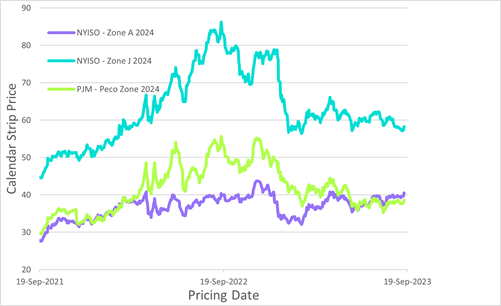Smartest Insight | Issue 135

Our weekly company round-up covers the key market and industry news in one place, so you don’t have to look any further to stay ahead.
September 20, 2023
Market Update:
Natural Gas prompt month is down about $0.10 on the day after yesterday’s short-lived run up and flat week over week in the mid $2.70's. Gas has been range bound between $2.50-$3.00 and continues to be sensitive to bullish news. The market is taking any news as a reason to move the market up. The dissipation of summer heat is helping to control demand putting a lid on prices.
Natural gas and oil rig counts are up by 9 to 641 in the U.S. as reported on September 15. This is the first positive increase in rigs since July 7th. The rig count is a leading indicator of future demand for gas and oil.
The 8-14 day temperature outlook continues to show above normal temperatures for approximately 3/4 of the country, starting with Utah and Arizona eastward to the Atlantic.
For week ending September 15th, the natural gas storage expectation is for a build of +63 Bcf, which would put inventories at 3,268, which continues to put us over last year and the 5-year average.

Regulatory Report:
NYC Local Law 97 – Encouraging the transition from fossil fuels
New York City is proposing new rules to encourage building owners to transition from fossil fuel heating to electric heat pumps, aligning with the city's greenhouse gas reduction goals by 2030. These rules offer incentives in the form of credits for heat pump installations over the next decade, motivating the replacement of fossil fuel heating, particularly in the early compliance years. They also provide options for owners to show their commitment to electrification to avoid penalties.
This initiative is part of New York City's strategy to implement Local Law 97, established in 2019, which mandates emissions reductions for buildings over 25,000 square feet. The law targets a 40% emissions reduction by 2030 and complete decarbonization by 2050 compared to 2005 levels. While initially, property owners had flexibility in meeting these targets, the new rules offer a clear framework to encourage the shift away from fossil fuels.
The proposed rules focus on crediting beneficial electrification projects installed between 2021 and 2030, with credit values decreasing from 2027 and ending in 2029. These projects involve installing energy-efficient electric heating, cooling, or hot water systems that replace or displace natural gas, fuel oil, or less efficient electric heating. Owners can accumulate emissions reductions from electrification projects for future compliance.
These credits are expected to help many building owners meet the compliance standards. City analysis shows that around 63% of the 50,000 buildings subject to Local Law 97 currently exceed their 2030 emissions reduction targets, with approximately 40% needing energy efficiency upgrades alongside electrification projects.
The proposed rules also include penalties of $268 per ton of emissions exceeding established limits. To support owners during the COVID-19 pandemic and promote good-faith efforts, a process is outlined for owners to avoid penalties by showcasing progress in decarbonizing their properties. Collaboration with organizations like the New York State Energy Research and Development Authority, Con Edison, and National Grid USA aims to leverage a $5 billion energy efficiency and electrification program for retrofits. Additionally, low- and moderate-income multifamily building owners can use tax incentives to cover compliance costs.
NYC Climate Week
Climate Week NYC commenced with calls for a global shift away from fossil fuels and immediate, comprehensive efforts to curb greenhouse gas emissions. Leaders from corporate, political, and environmental spheres joined this annual event in New York City on September 17. However, the urgency of their messages is underscored by the growing concern that the world is likely to miss the Paris Agreement's most ambitious target: limiting global warming to 1.5 degrees Celsius above pre-industrial levels.
Adam Scaife, head of long-range climate prediction at Britain's Met Office, explained the daunting challenge ahead, emphasizing the need for rapid achievement of net-zero emissions to reach the 1.5°C goal. Unfortunately, current efforts fall far short of this requirement. The Met Office's recent report, backed by the World Meteorological Organization, predicts a 66% chance of global warming exceeding 1.5°C for at least one year between 2023 and 2027.
Laura Corb, McKinsey's sustainability practice lead for North America, acknowledged progress in renewable energy adoption and net-zero commitments but warned that we are still on course for a temperature increase of 2.5 to 3°C by the end of the century.
Scaife cautioned that global temperatures could rise by at least 1.2°C and potentially 1.4°C from pre-industrial levels by 2024, driven by warming in the Pacific Ocean due to El Niño. This could put the 1.5°C target behind us by the end of the decade, according to modeling by the Met Office and other scientific organizations.
Climate Week NYC coincided with the United Nations Climate Ambition Summit and is intended to set the stage for the COP28 climate negotiations in the United Arab Emirates. Many speakers emphasized the need to shift from discussions about action to actually taking the necessary steps to address climate change. Helen Clarkson, CEO of Climate Group, stressed the urgency of implementation, calling for transformative change at a pace that surpasses the Industrial Revolution. The pressing nature of the climate crisis is clear, with climate-linked natural disasters and continued greenhouse gas emissions highlighting the need for immediate, ambitious action.
